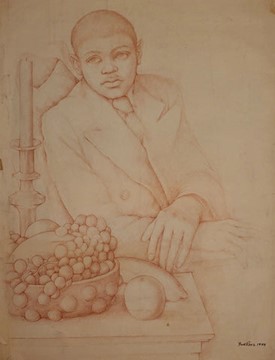“Black Voice, White Pen.” Graham Nickerson, [EDIT]ION, Volume 20, 2021.
Fred Ross, Drawing of a Black Youth, 1949 (Beaverbrook Art Gallery)
Black Voice, White Pen
By Graham Nickerson
The Beaverbrook Art Gallery was recently given a suite of early drawings by artist Fred Ross from the late 1940s and 1950s, and it includes some remarkable portraits of young Black Saint Johners. They are all from between 1948 to 1950, the time Ross started to teach at the former Saint John Vocational School. The drawings show the skill of the young artist, but they are also a window into deeper social and racial attitudes during the early postwar years.
Historian Harvey Amani Whitfield recently wrote that it is impossible to hear the Black voice without the intervention of a White hand. Though Whitfield was referring to the historical archive, the battlefield of memory is also playing out on the map as we decide who is and is not worthy of commemoration. Like statue removal throughout North America, Saint John has recently divested itself of slavery’s remnants associated with civic landmarks and street names. Like Saint John’s city map, the late Fred Ross’ drawings speak to conflicting visions of the past.
Ross’ realistic and sensitive portrayal of Black subjects is notable for the lack of racialized approaches inherited from previous eras. Depictions of black youth, especially ones done with care, dignity, and grace, were rare indeed in the canon of Canadian art of the time. However, in the current political climate and widespread concern over the lack of “Black voice,” one should ask whether Ross is an appropriate vehicle for the discussion of Black progress. Despite their honest portrayal, are these sketches a representation of the Black voice, or are they another example of the “White lens”? The Black experience as well as the White lens exhibit a spectrum of different perspectives, and Ross’s works challenge the accepted cultural norms of that time. To place his work in context, Fred Ross and contemporary Molly Lamb Bobak are likely the earliest New Brunswick artists to portray Blacks intentionally devoid of elements that hyper-sexualize or visually subjugate them.
Ross’ drawings represent a segment of Saint John’s Black population who were able to pursue secondary education, but they do not fully represent Blacks whose circumstances prevented them from such an education. Considering the impact of pre-civil rights era racism, New Brunswick Black community leaders Skip Talbot, Ralph Thomas, and David Peters have vastly different recollections. From documentary evidence, we have more than a glimpse of the racialized lens that existed in the province during that time. In 1949 for example, the Fredericton trial and execution of the impoverished Hamilton brothers produced a level of fanfare that rivalled the imagery of a southern lynching. Another example of New Brunswick’s ties to Jim Crow was the popularity of the travelling minstrel show. In July 1957, Atlantic Advocate magazine published a story on the Fredericton minstrel group “The Smokey Mokes,” beginning the racially charged piece with “Banjos strummin’, n****** hummin’…”

Fred Ross’ sketches provide a chance to contrast his depictions of Blacks with other racialized imagery of that time. The discussion of the Black voice must at times incorporate the White pen as a companion and as a point from which to begin a deeper investigation and wider, more inclusive conversation.
Graham Nickerson is a board member of the New Brunswick Black History Society and is pursuing graduate research on the subject at UNB.

